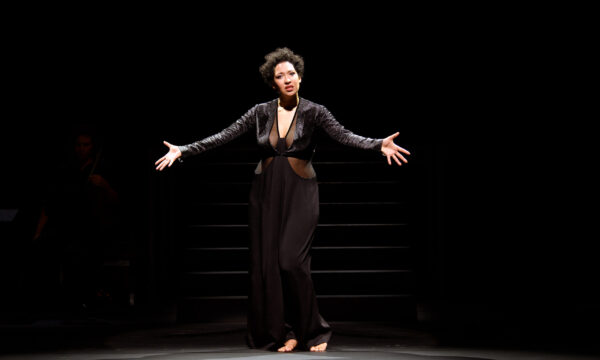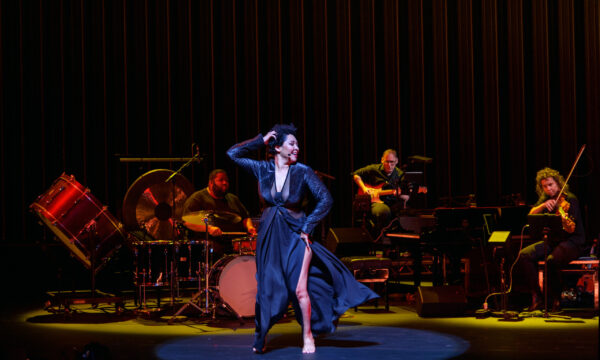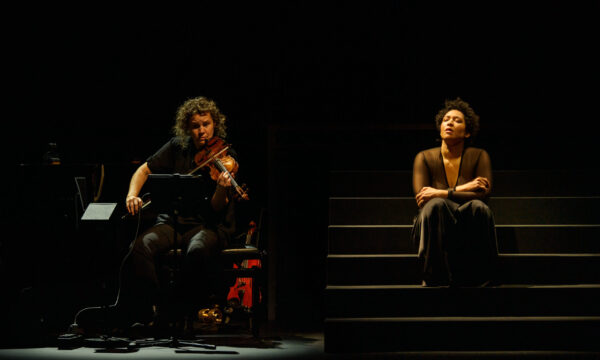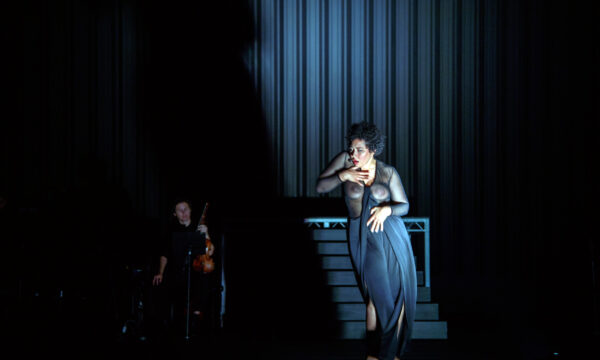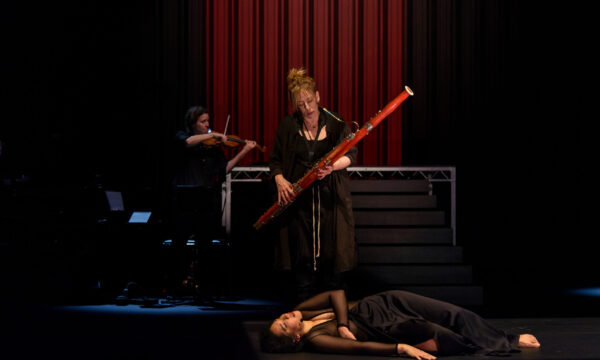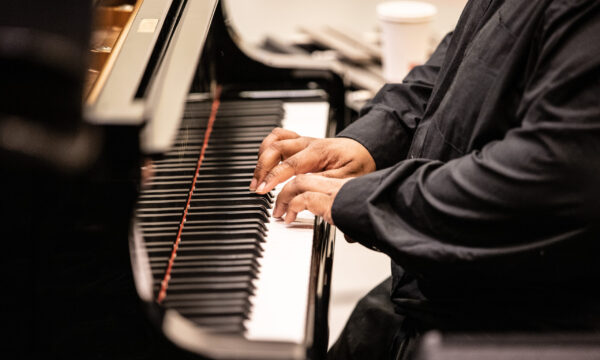Exposing Perle Noire: the development of Meditations for Joséphine’ by Julia Bullock
“Miss Baker… has, alas, almost become a little lady. Her caramel-colored body, which overnight became a legend in Europe, is still magnificent, but it has become thinned, trained, almost civilized. Her voice, especially in the vo-deo-do’s, is still a magic flute that hasn’t yet heard of Mozart… There is a rumor that she wants to sing refined ballads; one is surprised that she doesn’t want to play Othello. On that lovely animal visage lies now a sad look, not of captivity, but of dawning intelligence.”
JANET FLANNER, THE NEW YORKER 1930
I was first compared to Joséphine Baker when I began my studies of Western European classical music in college; and was told that because of the way that I looked, I would likely be asked to sing a lot of exotic repertoire. Sparked by complex feelings and questions around identity, I began to research the life, performances, and music of the entertainer, who, at that time, I identified as “the woman who danced in a banana skirt.”
My initial research revealed that Joséphine and I had a few things in common –– we were both born and raised in St. Louis, Missouri, danced a lot as children, and moved to New York to pursue performing. But this is where our paths diverged. Because of the discrimination she faced in the United States, she fled and emigrated to Paris in 1925. There she became not only the highest-paid female performer and the highest-paid Black performer, but the highest-paid entertainer the world had ever seen. This all occurred while, across the Atlantic, Jim Crow laws prevailed and women’s suffrage was less than a decade old.
Exoticism dictated her early career—she was sometimes dressed as a bird, locked in a cage, singing of her “home” in Africa (“Afrique”), even though she wouldn’t actually set foot there until later in life. Some may view this as exploitation, and there’s no escaping that fact. But I believe that for Joséphine Baker, it was the first time she could reveal herself in front of an audience on her own terms. Even my initial image of her in a banana skirt is a powerful one of agency – a female force at the center of a crude representation of male dominance.
While many speak of Joséphine’s larger-than-life presence through the lens of performance, I think her impact was most beautifully realized through her involvement in France’s resistance movement during World War II. Recognition from her home country wasn’t confirmed until the Civil Rights Movement, when Dr. Martin Luther King, Jr. invited her to speak at the March on Washington in 1963, and when Coretta Scott King asked her to be the face of the movement after King’s assassination.
So to say Joséphine Baker was turned into an icon would not be an overstatement. But for me she is not merely an icon for women; she is not just an icon for B/black people; she is an icon of liberty.
Baker challenged and combated her environment through various modes of expression. However, in music she was limited in terms of experimentation. She mostly worked as a vaudevillian dancer early on, and left the U.S. just as the Harlem Renaissance was coming into full bloom. She didn’t sing the blues and missed the beginning of the jazz age; although she flourished in the stylings of the French music hall—a neatly confined frame, where she could push boundaries without being too explicitly confrontational.
I first programmed songs for which Joséphine was known on a 2014 debut recital program. These songs touched on themes which seemed to pervade her life: exploitation and objectification, issues surrounding identity, the difficulties in maintaining intimate relationships –– as well as on the roles that she played: an exotic entity in a foreign place, a charmer, nurturer, and activist.
The director Peter Sellars later encouraged me to broaden my exploration of Baker and her influence as a performer. He invited the poet Claudia Rankine to contribute text; I felt it pertinent to consider Baker’s body through dance, so Peter asked the choreographer Michael Schumacher to develop a deconstructed Charleston; and the International Contemporary Ensemble introduced me to the composer Tyshawn Sorey. Together we compiled words, movement, and music that examined and highlighted various undercurrents of Joséphine Baker’s life in an effort to share an in-depth portrait of a dynamic being. In 2016, after performing the source material in a relatively raw form called: “Josephine Baker: A Portrait.” Tyshawn and I retitled the work, Perle Noire: Meditations for Joséphine –– the ‘Black Pearl’ being a term of endearment and adoration bestowed upon her during her life, and because this expansive project is not so much about her, but for her.
We’ve since shared Perle Noire: Meditations for Joséphine in a wide range of venues –– from outdoor theaters, to cabaret settings, to museums of visual art, and opera stages. Each time we return to this piece, it presents us with new opportunities to collectively reexamine the material and to further articulate how deeply the themes permeating Baker’s story still resonate today.
To offer performances of Perle Noire across the world carries significance, because Baker fled the U.S. with the hope to escape various forms of oppression and live with more freedom. However, despite her status and privileges as a sensational performer, she still had to reckon with the reality that dehumanizing, colonialist practices and attitudes were (and remain) unresolved in places where black and brown people want to feel safe and call home.
Baker once said, “Since I personified the savage on the stage, I tried to be as civilized as possible in daily life.” How exhausting it must have been for her to be preoccupied with how she was perceived, both onstage and off. Admittedly, I have also been afraid, as a performer and person, about how I would be projected and exposed as a woman of color in the public eye. But years ago, when I took on the charge of researching Baker’s history, and decided to embody that history onstage for others to witness, that fear dissolved.
Although the experiences of Baker parallel many of my own, including my recent emigration to Europe, I have never intended to impersonate Joséphine Baker. I am not interested in the projection of a B/black popular singer who is exoticized, eroticized, and proclaimed as an extraordinary exception to most B/black people. I also do not know how to play into the trappings of a brilliant black operatic soprano who represents absolute dignity and power, impenetrable in her strength, and ever grateful for opportunities. While I do not know how to play into those characterizations, because they do not reflect the complexities of a human existence, I do know that because of the sacrifices and successes of Black American performers who came before me, I will not be coerced to perpetuate the tropes or stereotypes forced upon my predecessors.
As I embody the shades, hues and dimensions of this material each night –– as I stand, walk, dance, and sing on platforms and in places that hold so much complicated, ruthless, and astonishing history –– I am walking as myself; a more fully incorporated person, who continues to increase her capacity to embrace where she has come from; envision where she wants to go; and aims to share a reality that is direct, clear, immediate, and speaks to us all, right now.
PERLE NOIRE: MEDITATIONS FOR JOSÉPHINE
Conception by Julia Bullock and Peter Sellars
Music by Tyshawn Sorey
Text by Claudia Rankine (with quotes by Joséphine Baker, adapted by Julia Bullock and Zack Winokur)
Directed by Peter Sellars (with contributions by Zack Winokur)
PAST PERFORMANCES AND FEATURED ARTISTS
Ojai Music Festival – Oberon American Reparatory Theater – The Met Museum – Dacamera – Dutch National Opera
Singer & Dancer Julia Bullock
Percussion, piano Tyshawn Sorey
Movement Direction by Michael Schumacher
Costume Design by Carlos Soto
International Contemporary Ensemble
Critical Acclaim
Her renditions of the nine songs, ranging in length from five or six minutes to 17 minutes, were all expertly delivered. Each was carefully crafted as Bullock threw herself into their emotional depths; her humiliation and sadness, anger and defiance cascaded forth as if released following years of suppression, although there was also room for her to express more tender emotions of love and happiness, such as in “Doudou.” The final piece, “My Father How Long,” taken from the 1867 anthology “The Slave Songs of the United States,” was particularly notable for the urgency and depth of feeling with which she was able to imbue the sentiments of the song in which she also made its resonance with today so very clear.
At the Metropolitan Museum of Art on Wednesday, the soprano Julia Bullock, the museum’s artist in residence, presented “Perle Noire: Meditations for Joséphine,” a tribute to the first black international superstar and a defining figure of the Jazz Age. Here, too, the diva shared center stage with an array of drums. But Ms. Bullock and her creative partner, the percussionist-composer Tyshawn Sorey, offered a very different image from the exoticized object of European fantasies… Their darkly captivating show offered a haunting investigation into the psychological shadows and public constructions that shaped the career of a woman who was “no more primal than Princess Grace,” as Ms. Bullock says in the piece, but for whom the most direct route to entertainment royalty and a chateau in the Périgord meant donning a banana skirt.
There were absolutely no bananas. At first glance, the program for soprano Julia Bullock’s Perle Noire: Meditations for Joséphine (Metropolitan Museum of Art, January 16–17) suggested a straightforward revue in tribute to Joséphine Baker, the sensational black Jazz Age performer who once titillated Parisian audiences by dancing in a skirt of synthetic bananas. Instead, Bullock — with members of the International Contemporary Ensemble; composer, pianist, and percussionist Tyshawn Sorey; and director Zack Winokur — offered a singular theatrical experience brimming with grief, resilience, and fury.
“The two-page, finely-written program notes Julia Bullock contributed for her production, Perle Noire: Meditations for Joséphine, performed on the stairs of the Metropolitan Museum’s Great Hall, takes me back to a practice I abandoned a couple of years ago–saving programs from all the shows I see. I no longer save them much beyond the year of their season, but this one, this one, will live with me, just as the life, struggles and example of Joséphine Baker clearly live with Bullock, a Black opera singer of profound insight and commitment to social justice.
The essay–which goes on to detail a creative process encouraged by director Peter Sellars ith a team of remarkable collaborators–ends in a proud, uncompromising affirmation of the complexity of human nature, Baker’s and Bullock’s as well. Both women aim to rip our stereotypes right out from under us.Is it possible to not only save program notes forever but stand up and give them a rousing cheer?”




